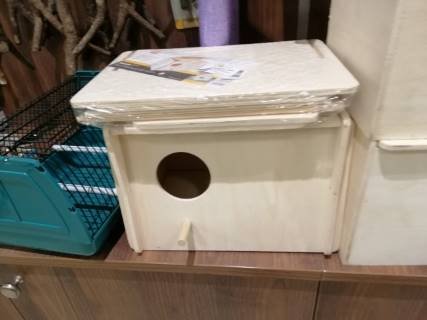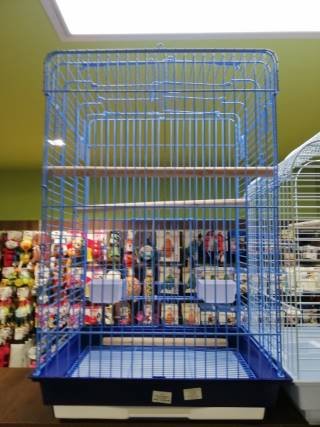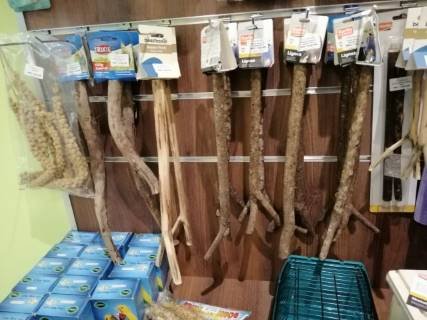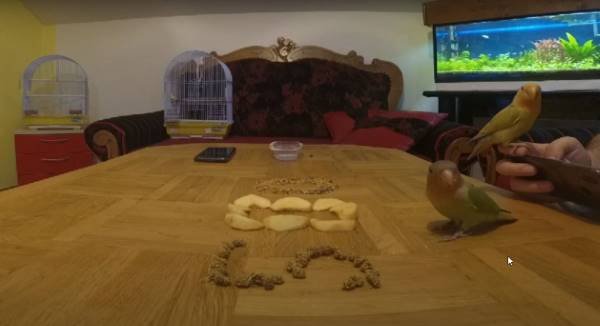Lineolated Parakeets are less common in many regions and chances are high that many wouldn’t have heard this bird’s name. But this doesn’t undermine the fact that they make a lovely pet bird and are favorites of many parrot lovers around the world. They are native to the wild highlands of Mexico City, Central America, and South America. They reside in high-elevation clouded forests and dense rain forests in mountainous valleys such as Peruvian Andes. They forage in the lower elevations at the time of winters. They are generally found in flocks up to 10 to 20 individuals.
Lineolated Parakeet Names
Lineolated Parakeets are adorably named as “Linnie”. They are smaller in size and have barred body type. Therefore, they are also famously called “Barred Parakeets”. Their Spanish name is “Perico Barrado” and the Latin name is “Bolborhynchus Lineola”. Catherine Parakeet is also one of the many names of the Lineolated Parakeet only.
Scientifically known as Bolborhynchus Lineola, Lineolated has two subspecies apart from the nominate one:
- Bolborhynchus Lineola Lineola
- Bolborhynchus Lineola Tigrinus
Lineolated Parakeet Size & Weight
These parakeets are sized around 6 to 7 inches. They can weigh anywhere between 42 to 52 grams.
Lineolated Parakeet Lifespan
The average lifespan of a Lineolated Parakeet is around 12 years. While in the wild, Lineolated Parakeets live for around 10 years. But in captivity, they can live up to 15 years. This can be attributed to extra care and attention extended to these little birds indoors by their human companions. Also, a balanced nutritious diet adds greatly to this difference.
Lineolated Parakeet Colors
Before detailing their colors, it’s interesting to know a little about their unique appearance. Lineolated Parakeets are called the Linnie because of the lining on their bodies. They have a stockier and a contoured body. These contours or stripes earned them the name ‘Barred Parakeets’.
Naturally, Lineolated Parakeets are green. They can be seen all green in the wild. Their body is mainly a brighter shade of green. The cheeks and belly are lighter green. However, a darker shade is found on their wings. They have black details on their feathers tips and blue details on lower wings. The undersides of their wings are in a shade of blue, while the tail feathers are dark green. These parakeets have a grayish beak and brownish eyes.
Lineolated Parakeet Mutations
Captive Lineolated Parakeets can be found in a variety of color mutations. Their feathers’ color tends to change after they leave their habitat. The various color mutations of Lineolated Parakeet include olive green, yellow, white, violet, turquoise, blue, and cobalt.
The male and female Lineolated Parakeet can be identical. A good observer may pay attention to the black stripes that are more in males Linnies across varied colors and subspecies.
Lineolated Parakeet Breeding
Lineolated Parakeets are dimorphic. Males and females can be identified vaguely. Still, it is not a good idea to rely on their appearance for determining their gender. To determine the gender of a Lineolated Parakeet, DNA sexing or surgical sexing must be performed.
If a person is starting with breeding birds, Lineolated Parakeets are considered as an ideal choice. Their calm nature makes it easier to breed. Another best part of breeding Lineolated Parakeets is that they aren’t demanding in terms of space. They have even been bred in mixed aviaries containing Canaries, Finches, and Neophema Grass Parakeets. Where such kind of environment makes breeding other species impossible, it has not been the case with these little parakeets.
Many breeders also breed them in a colony environment. They live in a flock of around 20 individuals in the wild. And they have also been seen in flocks of up to 100 parakeets. This way, it is advised to provide at least three nesting boxes for two pairs for comfortable breeding in a colony set up. One can also breed them in standard Budgie nest boxes. Mostly, horizontal style nesting boxes are used for Lineolated Parakeets.
Breeding Environment
For breeding, the comfortable size of the cage will be 40cm×40cm×100cm. The nest box can be affixed to the rear end or outside the cage, on one end of it. The latter way will allow for easy nesting inspection and cleaning. When someone is breeding more than one pair of these parakeets, placing them in a larger cage during the offseason is recommended. It will make them naturally select their pairs when the breeding season will arrive. This will ultimately result in a better success rate of breeding. However, this doesn’t apply to breeding the color mutations of this parakeet.
At the bottom of the nest box, a thin layer of shavings must be placed for retaining the perfect temperature inside the box. Additionally, for nesting materials, fibers like palm fibers and coconut fibers must be made available to Linnies for use. They will create a dome cavity with such extra fibers. Female Linnies will deposit their eggs there.

Considering the way Linnies like their privacy, the inspection must be kept to the minimum. The nest box should be inspected for eggs once a week until the first egg is laid. They can lay 4 to 5 eggs in a clutch. After this, the inspection can be skipped until the pair starts hatching. The incubation period of Lineolated Parakeets is about 19 to 22 days. The exact days depend on when the incubation starts after the production of eggs. The young chicks will leave the nest box after around 5 weeks of hatching.
The availability of various color mutations in Lineolated Parakeets has caught the interest of many breeders across the globe. These color mutations include Dark Green, Cinnamon, Creamino, Mauve, Lutino, Turquoise, and Cobalt. The Creamino and Lutino are often sex-linked and the blue ones are recessive. The Mauve mutation is a double dominant dark factor. It needs an experienced breeder to successfully breed a color muted Linnie pair.
Lineolated Parakeet Cage
Lineolated Parakeets are small birds. They don’t require a large cage. That said, the cage mustn’t be so small that the bird just fits in. If one can manage, the bigger the cage, the better it would be. For keeping a single Linnie, the minimum size of the cage can be 24 inches in square shape. Keep the bar spacing of not more than half an inch to keep the bird from sticking his neck out and getting hurt.
A cage is a place where Linnie would happen to spend most of his time on a typical day. So, keeping all the necessities handy for the bird inside the cage itself is important. It is also imperative to maintain a minimum hygiene standard of the cage to keep these little birds healthy.
Cage Accessories
The first important cage addition is feeding bowls. They are meant to maintain an uninterrupted food and water supply for the bird. Usually, two dishes/bowls are ideal to add to the birds’ cage; one for keeping some soaked seeds for the sudden hunger pangs for the bird in-between his usual meals; and the other for keeping the freshwater for the bird to stay hydrated. In hotter times, it is advised to add another water bowl as a back-up supply, in case the bird feels extra thirsty due to heat.

The next important cage accessory is the perches. It simulates the natural habitat for the Linnies and the bird feels at home. Perches keep the Linnies fit in the wild as they keep hopping from one perch to another. And such an opportunity must also be available to them in captivity for their optimum physical health. Add a few perches of varying lengths and thickness angles differently inside the cage.

Lastly, add a variety of toys to make Linnie’s cage a comfortable abode. There are many toys available in pet stores or online that can keep these birds engaged and entertained all day long.
Cage Hygiene
To prevent the bacteria from breeding inside the bird’s cage, it is important to give a regular wash to it weekly or fortnightly. If washing it with soap and water is not possible, clean it thoroughly with wet wipes to remove all the bird droppings or dirt.
Lineolated Parakeets Gender Differences
Though Lineolated Parakeets are sexually dimorphic, there are a few minute differences that help tell Linnie’s gender apart.
The difference can be seen in the size of the black area at the tip of their tail feathers. The girl parakeet will have fewer black details than the boy parakeet. Like the tail, their shoulders have the same difference in girls and boys.
Lineolated Parakeet Food
Because of the small size, Lineolated Parakeets don’t eat as much as other pet parrots. They eat a little meal portion when they are hungry. In the wild, Linnies eats a mixed variety of fruits, seeds, and larvae.
When in captivity, one should make sure to keep them healthy by feeding a wholesome balanced diet. They must be fed with high-quality pellet mix and seeds as well as a rich variety of fresh vegetables and fruits. It is recommended to offer them more vegetables than fruits, as fruits can cause them digestive concerns.
The market-made commercial pellets and seed mixes are specifically designed for parakeets to replenish them with nutrients that are a must to keep their diet perfectly balanced. These mixes are great to start with their basic nutritional diet. The Linnie babies are fed only such baby mixes.
Linnie Parakeets enjoys eating fresh sprouts and millet spray. Offer calcium supplements in the form of cuttlebone or mineral block.
Here is the list of what should be served to Lineolated Parakeets:
- A mixture of seeds: A few sunflower seeds with more canary seeds.
- Oat groats to be offered once a week.
- Fruits and vegetables: Pear, carrot, apple, maize, corn on the cob, lettuce, green seedless grapes, broccoli.
- Wheat bread, cooked bean mix, egg food.
- Spray millet.
- Cuttlefish and mineral blocks.
- Grit and freshwater.
Lineolated Parakeets are “Water Lover”
Linnie Parakeets are reputed for being enthusiastic bathers. They love having a bath-time in a shallow water bowl. Many Linnie Parakeets also love to take a shower with their owner.
Lineolated Parakeet Health
Lineolated Parakeets may suffer from the same diseases as other pet parrots. That said, many such diseases are fatal in small birds like Linnies and the treatment may be very difficult. Hence, it is always imperative to take preventive measures to not let the disease catch this little parakeet in the first place.
These tiny and cartoonish parrots may look happy-go-lucky. Yet, they are easy to fall off the track. This off-behavior can stress them out and make them a victim of loneliness and depression. It is always advised to take some time out from a typical day to pamper these birds.
Also, these healthy-looking parrots are prone to malnutrition and obesity if not cared for properly. Common health concerns for Linnies are eye infections and respiratory infections.
A few of the health problems of Lineolated Parakeets can also arise due to vitamin deficiency. This is a simple concern that can be treated with a properly balanced diet. That said, these birds are prone to fatty tumors, so the number of seeds and sprouts should be limited in their diets. Take the guidance of the vet to know the nutrient profile in the bird’s body to plan his diet accordingly.
It is advisable to keep a Lineolated Parakeet under a regular check-up of a professional veterinarian. With some basic care involving regular exercise, nutritional diet, and regular check-ups, all such health troubles can be avoided.
Lineolated Parakeet Talking Ability
Lineolated Parakeets can talk a lot. They tend to chatter instead of screech like many other parakeet species. They have enunciating and clearer vocabulary than other pet birds. They can make a great sound of mimicking and whistling in their cute voice. They are also famed for memorizing melodies and repeating them in cheerful chirps. They have natural soothing tweets that are pleasing to hear.
Are Lineolated Parakeets Loud?
A quality that makes Lineolated Parakeets loved and popular among parrot lovers is their calm and peaceful demeanor. Unlike other parakeets, they aren’t noisy. If a person living in an apartment is looking for a pet parrot companion, Linnies can be his apt choice. They are playful minus the painful loudness.
Lineolated Parakeet Training
Lineolated Parakeets’ intelligence makes them a great learner. Hence, it gets easier to tame them. Before training them, it is best to learn about their environmental requirements, eating and drinking habits, social needs, and health care.
Another important fact about Linnies is that they love a cleaner environment. So, keeping them clean will eventually lead them to “Reach out and touch you”. Moreover, it will enhance their happiness level as well.
Lineolated Parakeets are reckoned and reputed parrots as being hand raised and hand-fed.
Hand Tame
Lineolated Parakeets are good with hand tame training. Hand taming doesn’t always feature the parakeet sitting on the owner’s hand, it simply refers to the relative sense. They may enjoy sitting atop human shoulders, chest, or sleeves.
But to make that happen, it is essential to make a good bond with them. The daily interactions will create a desire in Linnies to bond with their human flock. The owner must let them be themselves. The stress and pressure may cause nervousness and edginess. Understanding them plays a significant role to make them feel comfortable with your presence. Also, one must always remain positive while training a Lineolated Parakeet.
The 5 key factors of training Lineolated Parakeets are:
- Understanding
- Love
- Care
- Kindness
- Patience (a lot of).
Lineolated Parakeet Intelligence
Lineolated Parakeets are intelligent or let’s say highly intelligent.
Picks up instructions well
They are famed for getting hand-tamed quite easily. Unlike a few other parrot species, they take to all the instructions of their human companion pretty well and quickly.
Mimics extraordinarily
The mimicry abilities of Linnies are touted as extraordinary and they are famed for copying the voices and whistling them back perfectly.
Great memory
Linnie Parakeets are also known for their great memory abilities. They can easily memorize their training sessions, the words and phrases taught, and even numerous songs in their short lifespan.
Conclusion
Lineolated Parakeets have the potential to make a human fall in love. They have a charming and mesmerizing personality. They are silly and energetic. It makes them as funny as a clown. The highlighted personality trait of a Lineolated Parakeet is his nature to cuddle. They love to cuddle and have a human touch. This has made them earn quite a name in the pet world in recent years. And with parrot lovers fascinated by vivid colors of these little creatures, the varied color mutations serve the purpose. So, to say, this species has something to offer to everyone. For the eyes, Linnies are a sight to behold. And for the soul, they offer loyal and Funtime all their life. Not to forget, the love and affection they deserve while at home must, however, be unconditional.
Featured photo credit: Timo Helgert / CC BY (https://creativecommons.org/licenses/by/2.0)





